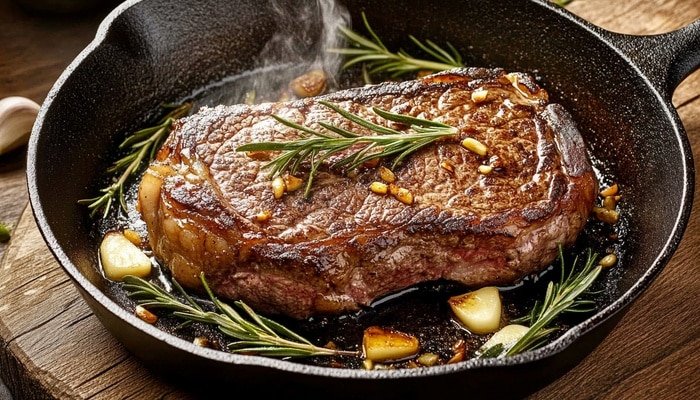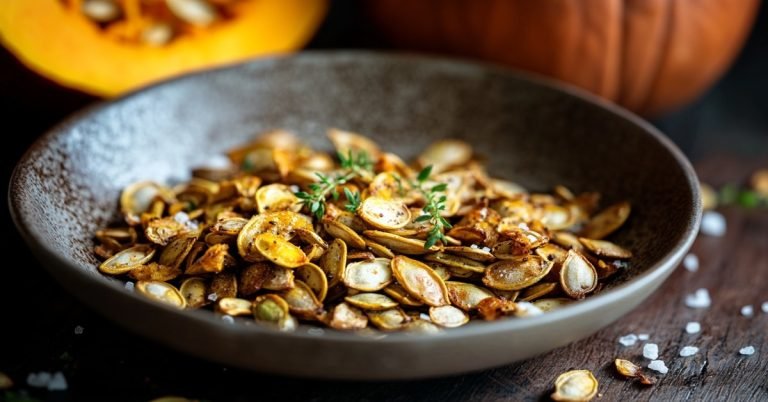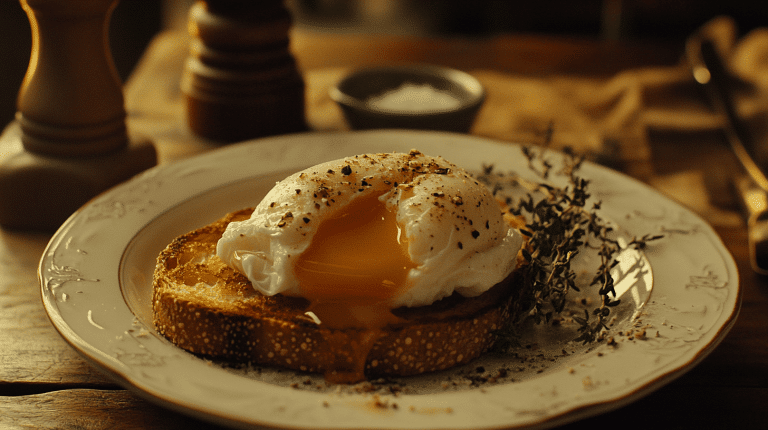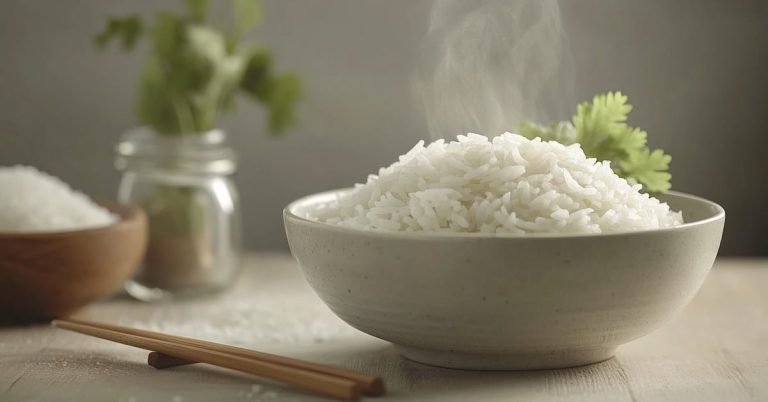To cook with cast iron, you’ll need to master three essential steps: proper preheating, seasoning, and ingredient management. Start by preheating your skillet over medium heat for 8-10 minutes, ensuring even temperature distribution for consistent results. Season your pan with high smoke point oil at 350°F for an hour, creating a natural nonstick surface that improves with each use. When adding ingredients, give them space to brown instead of steam, and let meats develop a perfect crust without moving them around. With its superior heat retention and versatility, cast iron transforms ordinary ingredients into restaurant-quality dishes. These time-tested techniques will elevate your culinary skills to new heights.
Key Takeaways
- Preheat your cast iron pan over medium heat for 8-10 minutes until evenly heated throughout before cooking.
- Season the pan with high smoke point oil at 350°F for one hour to create a natural nonstick surface.
- Clean only with hot water and a stiff brush, avoiding soap to preserve the seasoning.
- Allow meat to develop a crust without moving it, and give ingredients space to brown rather than steam.
- Dry the pan thoroughly after cleaning and apply a light coat of oil while still warm.
About
Cast iron cooking stands as one of the oldest and most reliable methods of food preparation, dating back thousands of years. You’ll find that this time-tested cooking method has remained popular because of its incredible versatility and ability to create delicious meals that bring people together around the table.
When you’re cooking with cast iron, you’re joining a tradition that spans generations of home cooks and professional chefs who’ve relied on these sturdy pans to create everything from perfectly seared steaks to golden cornbread.
You’ll discover that your cast iron skillet becomes more than just a cooking tool – it’s an investment in your culinary future. As you use your pan, it’ll develop a natural nonstick surface that gets better with each meal you prepare. The pan’s exceptional heat retention means you can achieve restaurant-quality results, from beautifully crusted meats to evenly baked desserts.
Whether you’re an experienced cook or just starting your culinary journey, cast iron cooking offers you a reliable, versatile, and rewarding way to prepare meals that’ll impress your family and friends.
Steps
Steps for Cooking with a Cast Iron Skillet
Cast iron cooking is a traditional method that brings unmatched flavor and versatility to your kitchen creations. The steps for cooking with cast iron may seem overwhelming at first, but once mastered, they become second nature and lead to consistently delicious results.
Before diving into the cooking process, it’s vital to understand that cast iron requires specific care and attention. A well-maintained cast iron skillet will serve as a reliable cooking companion for generations, making the effort to learn proper techniques worthwhile.
Begin by preheating your cast iron skillet over medium heat for about 10 minutes to ensure even heat distribution.
Next, season your skillet if necessary by coating it with high smoke point oil and baking it at 350°F for an hour.
Once ready, add your ingredients to the preheated pan, adjusting cooking times as necessary since cast iron retains heat longer than other cookware.
After cooking, clean the warm skillet with hot water and a stiff brush, avoiding soap.
Finally, thoroughly dry the skillet and apply a light coat of oil while still warm, heating it briefly on the stovetop to allow the oil to penetrate the surface.
Before attempting to cook with cast iron, keep in mind that these pans require patience during the heating process and careful temperature control.
Avoid cooking acidic foods in newly seasoned skillets, and always make sure the pan is completely dry after cleaning to prevent rust.
Additionally, using metal utensils is perfectly acceptable, as they can actually help maintain the seasoning of your pan over time.
With proper care and attention to these steps, your cast iron cookware will continue to improve with each use.
Step 1. Preheating Pan for Success
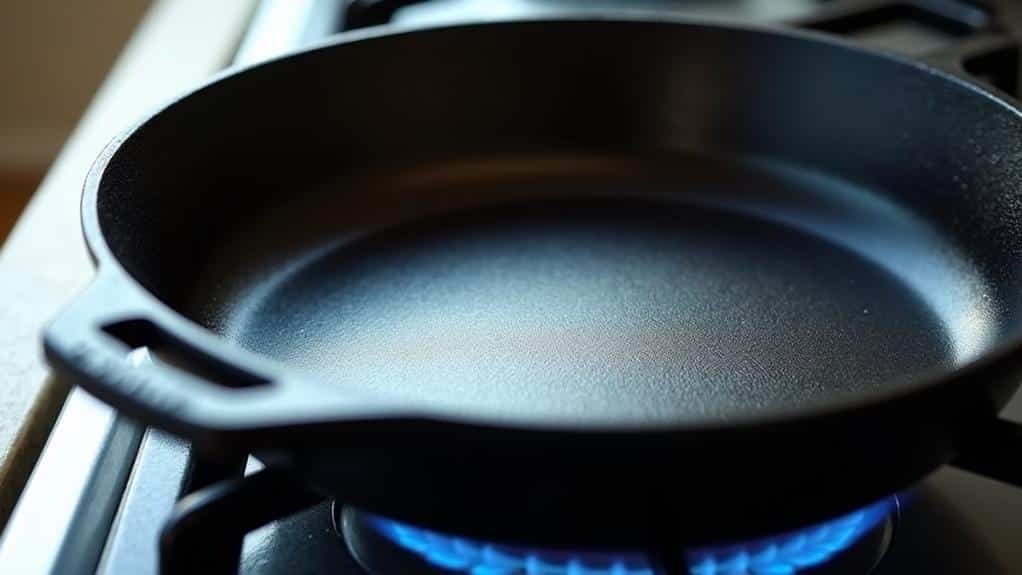
Properly preheating your pan stands as one of the most essential steps for successful cast iron cooking. When you’re working with this time-tested cookware, you’ll want to place your skillet over medium heat for about 8-10 minutes before adding any ingredients, which allows the entire cooking surface to reach an even temperature, preventing cold spots that could lead to sticking or uneven cooking.
You’ll know your pan is ready when you can feel the heat radiating up from the surface by holding your hand about 6 inches above it, and a few drops of water will dance and sizzle when they hit the surface.
While it might be tempting to rush this step, remember that your ancestors who cooked with cast iron understood the importance of patience in this process. A well-preheated pan will give you those beautiful, golden-brown crusts on your steaks, the perfect sear on your vegetables, and those crispy edges on your cornbread that we all love.
Since cast iron retains heat so well, taking the time to preheat properly guarantees you’ll get consistent, professional-quality results every time you cook.
Step 2. Seasoning Your Cast Iron
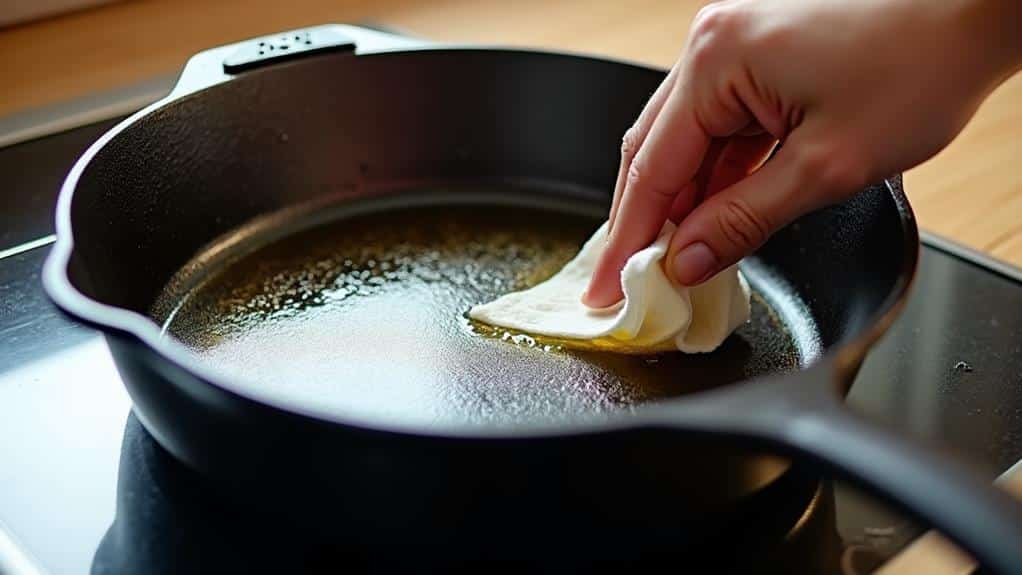
The art of seasoning transforms a basic cast iron pan into a naturally nonstick cooking surface that will last for generations. When you season your pan, you’re joining a long tradition of home cooks who’ve relied on this time-tested method to create an impressive cooking vessel that gets better with age.
To season your cast iron, you’ll need to start with a clean, dry pan and a high smoke point oil like grapeseed, canola, or flaxseed. Begin by coating the entire pan, inside and out, with a very thin layer of oil, making sure to wipe away any excess with a clean cloth until the surface appears almost dry.
Place your pan upside down in a preheated 350°F oven, with a sheet of aluminum foil on the bottom rack to catch any drips. Let it bake for an hour, which allows the oil to polymerize and bond with the iron, creating that signature black patina.
Once the hour is up, turn off the oven and let your pan cool completely inside. You’ll know you’ve done it right when the surface has a subtle sheen and feels smooth to the touch.
Step 3. Adding Food Ingredients
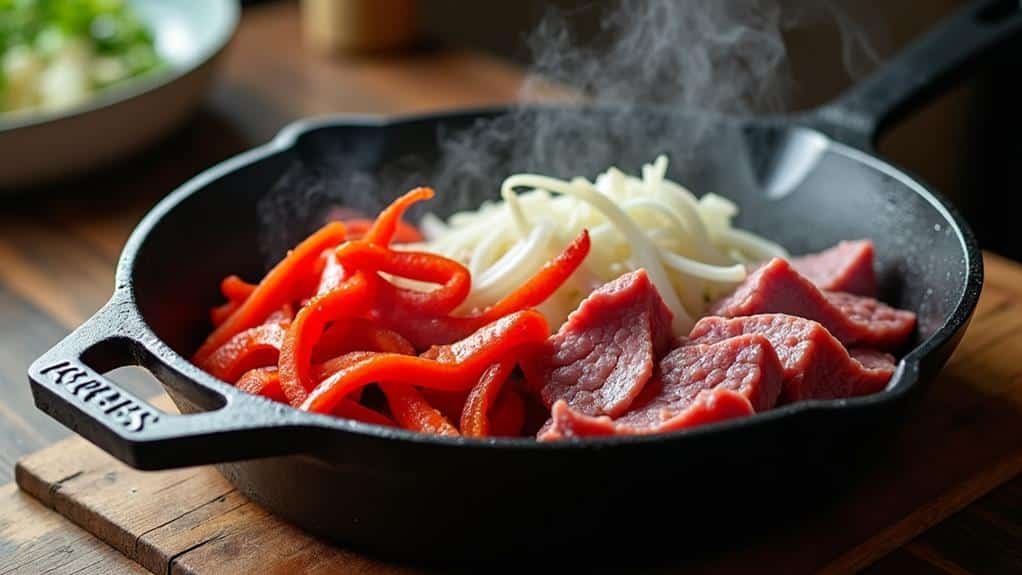
Successfully adding ingredients into a hot cast iron skillet requires proper timing and temperature awareness. As your pan heats up over medium heat for about 10 minutes, you’ll notice it developing an even warmth that’s perfect for cooking. You can test the temperature by sprinkling a few drops of water onto the surface – if they dance and sizzle, your pan is ready to go.
When you’re adding cold ingredients to your hot skillet, it’s important to give them enough space so they’ll brown rather than steam. If you’re cooking meat, place it gently in the pan and don’t move it around too much, which allows a perfect crust to form.
For vegetables, you’ll want to listen for that satisfying sizzle as they hit the hot surface, then spread them out evenly across the bottom. If you’re using oil or butter, add it just before your ingredients, watching as it shimmers across the dark surface of your pan. Remember that cast iron retains heat exceptionally well, so you might need to adjust your cooking times compared to other cookware, especially when you’re first getting used to your pan.
Final Thoughts
Mastering cast iron cooking requires patience and dedication, but the rewards are well worth the effort. Once you’ve developed a deep connection with your cast iron skillet, you’ll join generations of home cooks who’ve discovered the joy of this time-tested cooking method.
You’ll notice how your pan develops its own personality, becoming more versatile and reliable with each use, while creating those perfectly seared steaks and golden-brown cornbreads that your family will remember for years to come.
As you continue your cast iron journey, you’ll find that this durable cookware becomes an essential part of your kitchen arsenal, lasting for decades when properly maintained. Remember that every scratch and patina tells a story, and you’re adding your own chapter to the rich history of cast iron cooking.
Don’t be discouraged by initial setbacks – whether it’s a sticky surface or uneven seasoning – as these challenges are part of the learning process. With consistent care and proper technique, you’ll soon master this traditional cooking method and join the proud community of cast iron enthusiasts who understand that great cooking is about both skill and heritage.
Favorite Dishes to Cook with Cast Iron
Check out our recipe for Easy Roast Chicken in a Cast Iron Skillet to make the most of your seasoned pan and enjoy a delicious meal.
Frequently Asked Questions
Can I Use My Cast Iron Skillet on an Induction Cooktop?
Yes, you’ll love using your cast iron skillet on an induction cooktop! The iron material works perfectly with induction’s magnetic field, and you’ll get excellent heat distribution. Just make sure your pan’s bottom is flat.
How Do I Remove Stubborn Rust Spots From My Cast Iron?
Like removing gum from your disco shoes, you’ll want to scrub those rust spots with steel wool, then re-season your pan. Don’t worry – we’ve all been there! Simple vinegar soaks work great too.
Is It Safe to Store Leftover Food in Cast Iron?
You shouldn’t store leftovers in your cast iron pan. It’ll cause the seasoning to break down and can give your food a metallic taste. Instead, transfer your leftovers to a glass or plastic container.
Why Does My Food Stick Even After Seasoning the Pan?
You’ve seasoned your pan but still can’t flip that egg? Join the club! Your food’s probably sticking because you’re not preheating enough or you’re cooking at too high temperatures. Trust me, we’ve all been there.
Can I Use Metal Utensils With My Cast Iron Cookware?
Yes, you can absolutely use metal utensils with your cast iron! Unlike other nonstick cookware, your cast iron’s seasoning is tough and durable. Don’t worry about scratching – it’ll actually help smooth the cooking surface.

